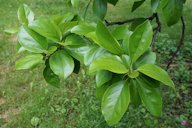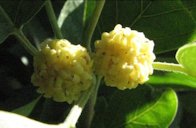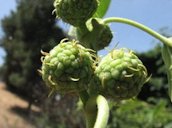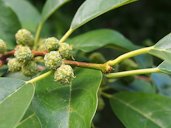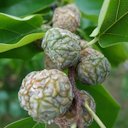| Che - Maclura tricuspidata | |||||||||||||||||
|---|---|---|---|---|---|---|---|---|---|---|---|---|---|---|---|---|---|
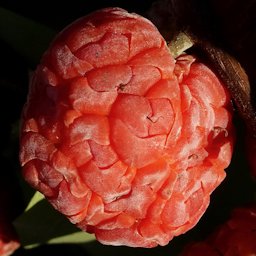 Fig. 1  Maclura tricuspidata, Cudrania tricuspidata 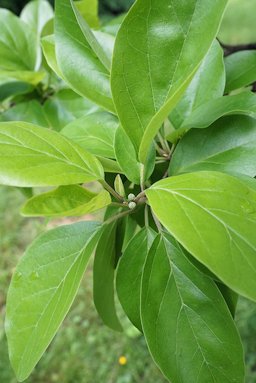 Fig. 2   Fig. 6   Fig. 7  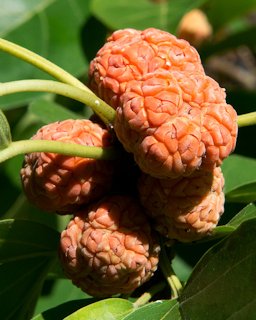 Fig. 8  C. tricuspidata 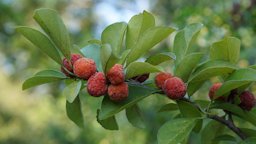 Fig. 9  M. tricuspidata 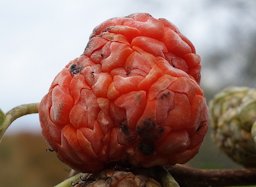 Fig. 10  C. tricuspidata, mature fruit  Fig. 14  The tree is not consistently thorny so there’s no pattern to help you avoid them 5 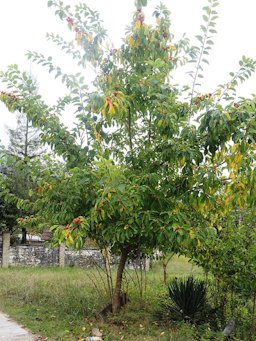 Fig. 15  Young M. tricuspidata tree  Fig. 16  M. tricuspidata tree 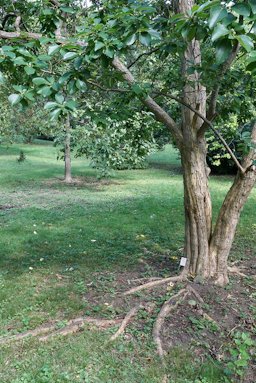 Fig. 17  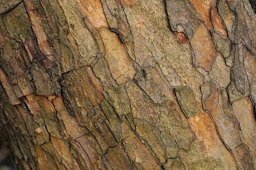 Fig. 18  Silkworm tree bark, C. tricuspidata by the stream at the Brooklyn Botanic Garden  Fig. 19  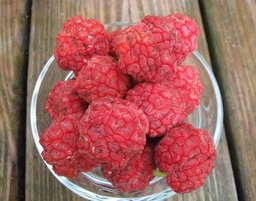 Fig. 20  C. tricuspidata |
Scientific
name Maclura tricuspidata (Carr.) Bur. Common names Che, Chinese che, Chinese mulberry, cudrang, mandarin melonberry, silkworm thorn, and, derivation unknown, storehousebush in English, and in China, tcho sang (wild mulberry), tsa, tse-tsang (thorny mulberry), cha-shu, poh-hsi, shih, nu-che 4 Synonyms Cudrania tricuspidata Bur. ex Lavallee; C. triloba Hance; Cudranus triloba Hance; Morus integrifolia Lév. & Vaniot; Vanieria tricuspidata (Carr.) Hu; V. triloba (Hance) Satake 7 Relatives Breadfruit (Artocarpus altilis), jackfruit (A. heterophyllus), fig (Ficus spp.), mulberry (Morus spp.), African breadfruit (Treculis africana) 1 Family Moraceae (mulbery family) Origin Native from the Shantung and Kiangson Provinces of China to the Nepalese sub-Himalayas 5 USDA hardiness zones 5-9; also grows well into subtropical regions 4 Uses Food; landscape ornamental; bonsai 11 Height 25 ft (7.6 m) to rarely 60 ft (18.3 m); female trees larger than males 5 Spread 25 ft (7.6 m) after 30 years 11 Plant habit Broad, spreading bush or small tree; suckers are produced at the base of the plant; with age develops a spreading flattened top 4 Growth rate Slow to moderate depending on location 11 Longevity At least 40 years 11 Trunk/bark/branches Immature wood thorny; branchlets slightly ridged, glabrous; bark ripples with deep furrows 4,10 Pruning requirement Prune only in winter when the plant is dormant; trees fruit on the current year’s wood 2,11 Leaves Evergreen in warm regions; alternate; pale yellowish-green; trilobate; frequently unlobed 5,11 Flowers Dioecious, male and female flowers on different plants, green, pea-sized 5 Fruit Aggregate fruit; knotty; ripens to red or maroon-red; juicy, rich flesh; 3-6 small brown edible seeds 5 Season July-Sept. Light requirement Will grow more vigorously and produce more fruit in full sun 2 Soil tolerances Prefers sandy, mildly acidic soil, but will tolerate a wide range of soil types 3 pH preference 6.1-6.5; tolerates pH 6.6-7.8 11 Drought tolerance Tolerant Flood tolerance Trees do not tolerate flooding 2 Aerosol salt tolerance Unknown Soil salt tolerance Unknown Cold tolerance - 20 °F (-28 °C) 1 Plant spacing Grafted trees should be planted on 20 ft (6.1) centers 2 Invasive potential * None reported Pest resistance Appears to be free of pests and diseases 2 Known hazard Fruit stains like mulberries 5 Terminal branches may be armed with sharp thorns 3 Reading Material Information, California Rare Fruit Growers Melonberry, Just Fruits and Exotics nursery Che: Chewy Dolloops of Maroon Sweetness, Uncommon Fruits for Every Garden pdf Che, Eat The Weeds Fruit of the Month: Che, California Rare Fruit Growers Origin This species is native to China and East Asia. It is widely distributed in southern Europe and other warm temperate regions of the globe. Che (Cudrania tricuspidata) was introduced to France in 1862, England in 1872 and to the United States about 1909. 5 Description Although it has not yet achieved the popularity it deserves, the che is well suited to dooryard planting in north and central Florida. This small tree is easy to grow, cold hardy, drought resistand and produces a berrylike fruit in great abundance. The flavor is mild, sweet and delicious. No significant faults are associated with the che, apart from sharp thorns and the tendency of some juvenile trees to form suckers around the base. 3 The deciduous trees can eventually grow to about 25 ft. in height, but often remains a broad, spreading bush or small tree if not otherwise trained when they are young. Immature wood is thorny but loses its thorns as it matures. Female trees are larger and more robust than male trees. 1
Leaves Leaves alternate, resemble mulberry but smaller, thinner, pale yellowish-green, trilobate, with central lobe sometimes twice as long as the lateral lobes, frequently unlobed. 5
Flowers The che is dioecious, with male and female flowers on different plants. Appearing in June, both types of flowers are green and pea-sized. The male flowers turn yellow as the pollen ripens and is released, while the wind-pollinated female flowers develop many small stigmas over the surface of the immature fruit. Male plants occasionally have a few female flowers which will set fruit. 1 Pollination No fruit is produced by the male but without his flowers the female won’t fruit. The male will cause seeds to be produced in the fruit of any female melonberry variety within pollination range. If you have a female melonberry that isn’t producing well or drops all its fruit, and you don’t mind seeds in the fruit, then plant a male melonberry within 15-20 ft of the female. 2 For some cultivars, females produce seedless fruit without pollination (parthenocarpy). If growing a seedless female tree, a male tree must not be present or the fruit will be excessively seedy. 11
Fig. 4. Male flowers turn yellow as the pollen ripens and is released Fig. 5. Female flowers develop many small stigmas over the surface of the immature fruit Fruit Like the related mulberry, the che fruit is not a berry but a collective fruit, in appearance somewhat like a round mulberry crossed with a lychee, 1 to 2 inches in diameter. The ripe fruits are an attractive red or maroon-red color with a juicy, rich red flesh inside and 3 to 6 small brown seeds per fruit. The flavor is quite unlike the vinous quality of better mulberries. While still firm they are almost tasteless, but when fully soft ripe they develop a watermelon-like flavor that can be quite delicious. The sugar content is similar to that of a ripe fig. In colder areas with early leaf drop the bright red fruit are an attractive sight dangling from smooth, leafless branches. 1 Although che fruits ripen late in the growing season, be patient with their harvest because they are tasteless until softened and dead ripe. Do not expect the fruits to drop into your hands at that time; each che has to be plucked individually (a case for parthenocarpy). Likewise, do not expect to pick the fruits all at once, because they have a long ripening season, a month or more. 4
Fig. 11,12. M. tricuspidata (syn. Cudrania tricuspidata, Cudrang), fruiting tree cultivated in Wrocław University Botanical Garden, Wrocław, Poland Varieties Cultivars of Note: 'Darrow Melon Berry' female, seedless, cantaloupe to papaya flavor, USDA zones 5-10. 'Norris Mandarin Melon Berry' female, seedless, watermelon flavor with fig overtones, more vigorous, USDA zones 5-9. 11 Harvesting The fruit are ripe when soft and darkening with age, possibly tinged black (Fig. 8). Ripe fruit can be removed from a stem with a gentle pull. If a hard tug is required, the fruit is not ripe. The stem does not bleed white sap when the fruit is picked fully ripe. Fruit ripen on the tree individually, not all at once, and do not ripen further once picked. One female tree can produce up to 400 pounds of fruit. It takes 5 months for the fruit to ripen. 11 The fruit can be kept refrigerated unwashed for several weeks in a covered container. 11 Propagation The che is readily grown from seed, although the plants can take up to 10 years to bear. Seeds should be sown as soon as extracted from the fruit. The plants are often propagated from softwood cuttings taken in midsummer and treated with rooting hormone. The che is also easily grafted to Osage orange rootstock using either a cleft or whip-and-tongue graft. 1 Osage orange is used as a rootstock because che on its own roots can sucker badly. Osage orange as a rootstock for che gives you a plant that is more easily trained as a standard, single-trunked shrub or small tree. 6 Both male and female trees can fruit, she more than he while the grafted seedless fruits the most. 5 Years before fruiting: ten years from seed, 2-3 years if grafted. 11 Planting Because space is usually limited, savvy gardeners have planted the male and female che in the same hole. The male is kept pruned to about ¼ of the total canopy for adequate pollination and best fruit production. 2 Plant away from walks, drives or patio, as fallen fruit stains porous surfaces. Terminal branches may be armed with sharp thorns. 3 Pruning Trees fruit on the current year’s wood. Prune heavily in winter to encourage new growth for best fruit production. Remove approximately half the branches formed the previous year and head back remaining shoots by about half. If the male and female have been planted together, keep the male to about 25% of the total canopy. This may entail addition summer pruning of the male. The trees can be allowed to reach full height or kept smaller for ease of harvest. 2 Fertilizing The type of fertilizer you choose may be chemical or organic. Make sure that the fertilizer contains iron, zinc, manganese, magnesium, molybdenum, copper and boron. These minor elements are very important to plants and most soils are low in these elements. Spread the fertilizer evenly under the entire canopy of the plant avoiding a 5-inch area around the trunk. Water or rake in. For Zones 8a-10, fertilize 3 times each year in February, May and late July/early August. For plants further north (Zones 6-7), fertilize 2 times each year in March and June/July. Never fertilize after August (July in Zones 6-7) as this will promote new growth late in the year which will be subject to freeze damage. 2 Irrigation The first year is a critical time for the establishment of a new tree. Water thoroughly twice a week on light soils and once a week on clay soils. Soak the entire root system deeply – this usually takes 40-50 minutes. Mandarin Melonberry should receive at least 1 inch of water each week for best growth and fruit production. Water regularly, especially during dry periods. Fruit may drop prematurely if insufficiently irrigated during dry spells. 2 Food Uses Use fresh in fruit salad or eat out of hand. They can be eaten raw or cooked. 2,11
Other Uses The plants have been valued by the Chinese for their leaves, as feed for silkworms. Although the silk produced from them was said to produce lute strings with a particularly clear sound, their leaves were used only to supplement mulberry leaves as feed, perhaps because thorny stems make picking them more difficult. 4 The bark fibers are used for making paper, and the bark is used medicinally. 10 General Incidentally an intergeneric hybrid exist between the Che (Cudrania tricuspidata) and the Osage Orange (Maclura pomifera) called Macludrania hybrida. Mostly from France they were planted in the US National Arboretum in 1960 and have large orange-like fruit and no thorns. Other than that planting the hybrid seems to have been largely ignored by everyone. 5 The Che is a favored tree of for bonsai. 5 The Tanzhe Temple west of Beijing, China, is named for this tree. 8 List of Growers and Vendors |
||||||||||||||||
| Bibliography 1 "Che." California Rare Fruit Growers, 1997, crfg.org. Accessed 4 Jan. 2014. 2 Gilbert, Brandy Cowley. "Melonberry." Just Fruits and Exotics nursery, justfruitsandexotics.com. Accessed 5 Jan. 2015. 3 Boning, Charles R. Florida's Best Fruiting Plants- Native and Exotic Trees, Shrubs, and Vines. Sarasota, Pineapple Press, 2006. 4 Reich, Lee. "Che: Chewy Dollops of Maroon Sweetness." Uncommon Fruits for Every Garden, 2004, leereich.com. Accessed 7 Jan. 2015. 5 Deane, Green. "Che." Eat the Weeds and other things, too, www.eattheweeds.com. Accessed 14 Jan. 2015. 6 Del Hota, Tom. "Fruit of the Month, Che." California Rare Fruit Growers, Dec. 2012 Newsletter, crfg.org. Accessed 17 Jan. 2016. 7 "Cudrania tricuspidata synonyms." Global Biodiversity Information Facility, gbif.org. Accessed 15 May 2017. 8 "Maclura tricuspidata." Wikipedia, wikipedia.org. Accessed 15 May 2017. 9 dself65. "Che (mandarin melon berry) Cudrania tricuspidata." Top Tropicals, tropicalfruitforum.com. Accessed 15 May 2017. 10 "Maclura tricuspidata Carrière." Flora of China, www.efloras.org/florataxon.aspx?flora_id=2&taxon_id=242331085. Accessed 9 Apr. 2022. 11 "Growing Mandarin Melon Berry, Che: Maclura tricuspidata." Garden Oracle, Apr. 2020, gardenoracle.com/images/maclura-tricuspidata.html. Accessed 9 Apr. 2022. Videos v1 "Che (Zhe) Fruit." Figaholics, 8 Oct. 2020, (CC0), www.youtube.com/watch?v=mjgXfVKJEnQ. Accessed 9 Apr. 2022. v2 "Che." Future Of Flavor, (CC0), www.youtube.com/watch?v=_5_AAeS41sg. Accessed 10 Apr. 2022. Photographs Fig. 1 Arb O'Retum. "Cudrania tricuspidata." Flickr, 6 Nov. 2021, (CC BY-NC-SA 2.0), www.flickr.com/photos/123413440@N05/51661279277. Accessed 9 Apr. 2022. Fig. 2 "Cudrania tricuspidata." Plant Image Library, 8 June 2017, Flickr, (CC BY-SA 2.0), www.flickr.com/photos/138014579@N08/35143130686. Accessed 9 Apr. 2022. Fig. 3 "Cudrania tricuspidata." Plant Image Library, 8 June 2017, Flickr, (CC BY-SA 2.0), www.flickr.com/photos/138014579@N08/35143130736. Accessed 9 Apr. 2022. Fig. 4,5 Gilbert, Brandy Cowley. "Melonberry." Just Fruits and Exotics nursery, justfruitsandexotics.com. Accessed 5 Jan. 2015. Fig. 6 "Cudrania tricuspidata." Plant Image Library, 6 Oct. 2017, Flickr, (CC BY-SA 2.0), www.flickr.com/photos/138014579@N08/37484748476. Accessed 9 Apr. 2022. Fig. 7 "Cudrania tricuspidata." Plant Image Library, 6 Oct. 2017, Flickr, (CC BY-SA 2.0), www.flickr.com/photos/138014579@N08/37484748616. Accessed 9 Apr. 2022. Fig. 8 "Cudrania tricuspidata." Plant Image Library, 7 Nov. 2017, Flickr, (CC BY-SA 2.0), www.flickr.com/photos/138014579@N08/26470315569. Accessed 9 Apr. 2022. Fig. 9 Chaoyue, Zhao. "Silkworm Thorn, Maclura tricuspidata, Shandong, China." iNaturalist, Research Grade, 10 Sept. 2020, (CC BY-NC 4.0), www.inaturalist.org/observations/59107502. Accessed 9 Apr. 2022. Fig. 10 Arb O'Retum. "Cudrania tricuspidata." Flickr, 2013, (CC BY-NC-SA 2.0), flickr.com. Accessed 15 May 2017. Fig. 11 Kwiecień, Agnieszka. "Maclura tricuspidata (syn. Cudrania tricuspidata, Cudrang), fruiting tree cultivated in Wrocław University Botanical Garden, Wrocław, Poland." Wikimedia Commons, 18 July 2020, (CC BY-SA 4.0), commons.wikimedia.org/wiki/Category:Maclura_tricuspidata#/media/File:Maclura_tricuspidata_syn._Cudrania_tricuspidata_2020-07-18_01.jpg. Accessed 9 Apr. 2022. Fig. 12 Kwiecień, Agnieszka. "Maclura tricuspidata (syn. Cudrania tricuspidata, Cudrang), fruiting tree cultivated in Wrocław University Botanical Garden, Wrocław, Poland." Wikimedia Commons, 18 July 2020, (CC BY-SA 4.0), commons.wikimedia.org/wiki/File:Maclura_tricuspidata_syn._Cudrania_tricuspidata_2020-07-18_03.jpg. Accessed 9 Apr. 2022. Fig. 13 Arb O'Retum. "Cudrania tricuspidata." Flickr, 22 Oct. 2013, (CC BY-NC-SA 2.0), www.flickr.com/photos/123413440@N05/17951961863. Accessed 9 Apr. 2022. Fig. 14 Arb O'Retum. "Cudrania tricuspidata." Wikimedia Commons, 2015, flickr.com. (CC BY-NC-SA 2.0). Accessed 15 May 2017. Fig. 15 SKas. "Maclura tricuspidata tree." Wikimedia Commons, 2008, (CC BY-SA 3.0), commons.wikimedia.org. Accessed 15 May 2017. Fig. 16 "Cudrania tricuspidata." Plant Image Library, 6 Oct. 2017, Flickr, (CC BY-SA 2.0), www.flickr.com/photos/138014579@N08/37484747836. Accessed 9 Apr. 2022. Fig. 17 "Cudrania tricuspidata." Plant Image Library, 6 Oct. 2017, Flickr, (CC BY-SA 2.0), www.flickr.com/photos/138014579@N08/37484748726. Accessed 9 Apr. 2022. Fig. 18 Severinghaus, Steven. "Silkworm Bark. Cudrania tricuspidata by the stream at the Brooklyn Botanic Garden." Flickr, 2012, (CC BY-NC-SA 2.0), www.flickr.com. Accessed 15 May 2017. Fig. 19 "Cudrania tricuspidata." Plant Image Library, 6 Oct. 2017, Flickr, (CC BY-SA 2.0), www.flickr.com/photos/138014579@N08/37484747496. Accessed 9 Apr. 2022. Fig. 20 Gilbert, Brandy Cowley. "Melonberry." Just Fruits and Exotics nursery, justfruitsandexotics.com. Accessed 5 Jan. 2015. * UF/IFAS Assessment of Non-native Plants in Florida's Natural Areas ** Information provided is not intended to be used as a guide for treatment of medical conditions. Published 5 Jan. 2015 LR. Last update 10 Apr. 2022 LR |
|||||||||||||||||
